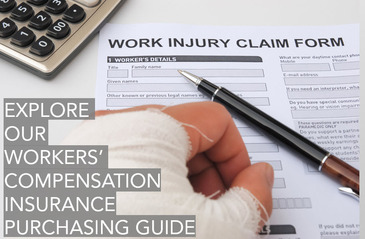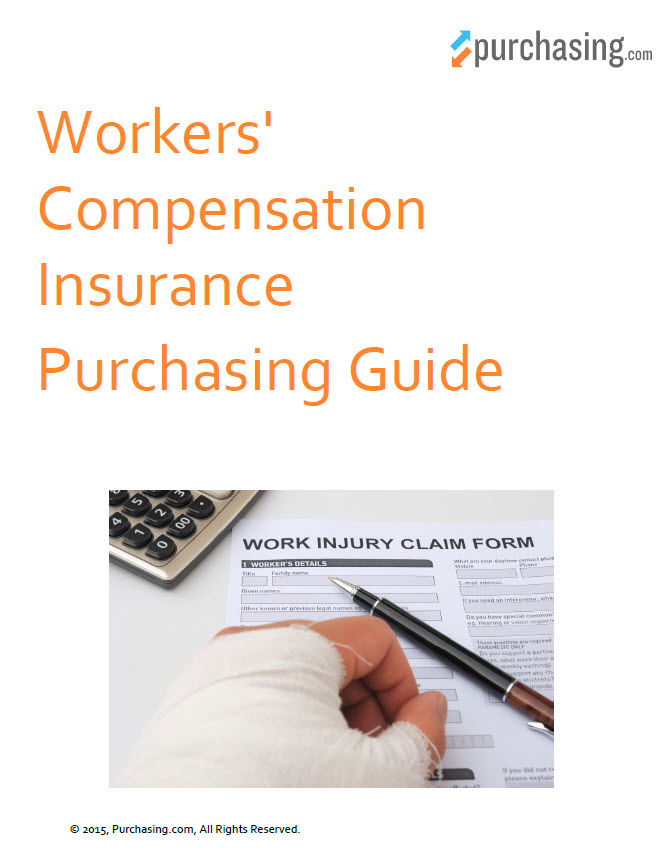Introduction to the Workers’ Compensation Insurance Buying Process
 Table of Contents
Table of Contents
- Introduction
- Trends
- Types
- Terms
- Choosing a Provider
Introduction
Businesses that have employees should have a workers' compensation policy. Workers' compensation insurance provides benefits for employees if they are injured or become ill as a result of their employment. In addition, it provides a vale of liability protection for the employer. In fact, most states require the coverage in some fashion.
Wisconsin was the first jurisdiction in the United States to require this type of coverage from employers as far back as 1911. It wasn't long before other states followed and began requiring employers to offer a no-fault system of protection to make certain workers received fair and prompt medical treatment and reimbursement in the event of a workplace injury or illness. These requirements evolved into a modern compensation system that allows employers to provide specific benefits in a predictable and affordable manner.
Insuring your business against employee claims is certainly as beneficial as insuring against claims from any other third party. Accidents can happen in spite of the best safety practices. All types of employers, but especially those in the construction industry, are encouraged to take the necessary steps in obtaining proper protection against injuries and illness in the workplace through wellness programs, safety education and employee participation in mandatory random drug testing.
Benefits
When an employer is considering some of the added benefits that come along with having adequate workers compensation insurance, there are many. The following are a few of the core benefits that could help a business cover the cost of a work-related injury to one of its employees:
- Income replacement to replace a portion of lost wages due to injury or illness.
- Medical coverage to cover the cost of medical services and fees for the injured worker.
- Burial expense should an employee die on the job.
- Death benefit to provide a percentage of lost income to the deceased worker's kin.
Purchasing considerations
As you consider workers' compensation insurance for your business and how it will benefit the employee and protect your business, it's important to keep in mind the unique risks in your specific industry. As you read this purchasing guide, think about how you can safely mitigate those risks by:
- Providing coverage for all workplace employees based on their job description
- Making certain independent contractors are covered by their own policies
- Understanding the limits within each coverage type and whether they are sufficient
This purchasing guide will help you make an informed decision about the inherent workplace liability that is presented to every business that has employees. Having an understanding of workers compensation insurance will help you develop a list of the most important questions to present to potential companies in order to obtain a level of comfort prior to making your decision.
Trends
Just as workplace risks change over time, so does each insurance product designed to cover those risks. Typically, the insurance industry will respond to the marketplace as it morphs and present redesigned products and services to accommodate changes in each industry. The following are common trends that continue to influence workers' compensation insurance and could influence your final decision.
Reclassification of employees
Over the past decade, many service type classes such as artisan contractors, have moved toward the "independent contractor" form of relationship with their workers, including remote or telecommuter employees. This was done in hopes of reducing payroll tax liability, insurance costs and retirement plan liability.
In response to this, the IRS and state worker's compensation boards have created a type of "smell test" that is used when distinguishing these types of workers. Since each state regulates the worker's compensation rules, rates and regulations for their jurisdiction, the employer will need to take this into consideration when determining how they will classify their workers.
Workplace safety practices
Insurers are willing to offer discounts to those employers who are willing to help mitigate their losses. The discounts are awarded for implementing prescribed safety precautions and practices based on the class of business (drug testing being included as well). As a result, many larger organizations are now implementing the use of an experienced risk manager to implement the different programs encouraged by their insurers. In some cases, the insurance carrier will offer their own risk managers to consult with employers.
Another popular option is to outsource the risk management services to an independent consultant, thereby, reducing employee costs when compared to the long term savings on worker's compensation insurance.
Even though coverage for different types of pandemics are available to workers under most worker's compensation policies, the fact that the illness must be specific to the job will in many cases, rule out coverage; however, safety precautions should be taken into consideration nonetheless. All of the previously mentioned activities can substantially reduce the employer's annual cost of insurance.
The election of deductibles in the insurance agreement can lead to significant savings as well. The deductible is the portion of the claim that the employer is willing to pay before the insurance coverage kicks in. Determining a deductible selection should always be based on what the company can afford to pay out of pocket for each and every claim reported.
New companies without loss experience may want to put off using deductibles until after they have compiled a loss record over at least five years, so that selection can be based on statistics rather than the availability of funds.
Back to top
Types of Claims
When it comes to workers' compensation insurance, employers have a variety of options for the types and coverage they want. Each state sets their minimum requirements which are the minimum limits required in that state. The limits are set according to each injury, each illness and an aggregate limit as well. Most private insurers offer a maximum limit of $1 million dollars aggregate. The employer may also select a deductible that is applied per employee which results in a rate decrease since the employer is electing to assume a dollar amount of the risk.
Below, we'll go into more depth on the types of claims.
Medical & Incident only claims
Medical care is available to the employee when injured while performing their job. The incident must be job-related, but does not have to happen while at the workplace. For example, if a construction worker is driving to a vendor to pick up supplies and is in a car accident, the worker's compensation pays for injuries rather than the auto policy.
Job-related illnesses are also covered for the employee. For instance, stress-related illness would apply as long as the illness is a result of the job.
- NOTE: When an employee collects worker's compensation benefits, the employee is then unable to bring an action against the employer. Employees are not compensated for pain and suffering under the benefits of the policy either.
Incident-only claims must be filed immediately and are for minor incidents. For instance, if an employee slips on the stairs. The claim will go to the insurance agency who will determine what compensation and benefits should be provided - if any.
Lost time claims
Worker's compensation coverage will also respond to long-term injuries such as carpal tunnel syndrome or back and neck injuries that result from repeated movements in the workplace. Long-term effects from chemical exposures, due to environmental hazards, can be triggered many years after an employee leaves a job. For instance, mesothelioma, which is still being discovered and litigated today in workers that have been exposed to hazardous chemicals during their lifetime of working in industrial environments.
 Disability can be presented in different ways depending on the nature and expected disability resulting from the injury or illness:
Disability can be presented in different ways depending on the nature and expected disability resulting from the injury or illness:
- Partial Disability: A worker is injured but can return work to but is unable to perform their regular duties and are assigned "light duty" responsibilities.
- Temporary Total Disability: The injured or sick worker cannot perform any duties but is expected to return to work within a short period of time.
- Permanent Total Disability: The injury or illness is considered a lifetime disability and prevents the worker from returning to work in any position.
To be able collect for long term or permanent disability under the workers' compensation policy, the worker will be required to prove that:
- The injury or illness was work-related or happened at work
- The severity of the injury or illness has rendered them disabled or impaired
- The disability makes it impossible for the employee to return to work in any position
Death claims
In the event that an employee dies due to a work-related incident, the death benefit payable to surviving dependents under worker's compensation is typically calculated based on a percentage of the deceased worker's earnings within a maximum limit. The death benefit is used not only to pay for funeral and burial costs, but also to provide financial assistance to the surviving spouse and minor children. Each state determines the rules and regulations regarding death benefits.
Income loss & fraud
Many work-related injuries or illnesses result in a loss of income to an employee who is paid based on time at work. Depending on the state, your business is located; income benefits are normally available after a short waiting period if the employee is unable to return to work. In most jurisdictions, loss of income is limited to approximately two-thirds of the employees average wages paid. The benefits paid are not taxable which makes the recovery of lost wages more realistic, and the wage loss benefit will trigger after just a few days of missed work.
Although the workers' compensation policy is designed to cover injuries and illness resulting from a workplace incident, certain exclusions exist. For example, in most states, the insurance company is allowed to ask the injured worker for a drug test immediately after an incident. If the drug test reveals that the employee was not sober at the time of the claimed incident, benefits may be denied by the company.
Also, compensation is more than likely going to be denied for the following reasons:
- The injury or illness was self-inflicted
- The employee was breaking a law or not following company policy
- After proper investigation, it's been proven that the employee was not on the job at the time of the injury
Terms & Criteria
State workers' compensation applications are similar - except for when various supplement forms are used based on the industry of the applicant. The Acord 130 Form is the standard for gathering the required information whether online or on paper. The most important information to have ready for the agent or broker is:

- Company contact and general information
- Years in business
- Locations
- Entity type
- Description of the business and services or products provided
- Rating information
- Types of employees (full or part time)
- Their annual payroll
- Job description (classification)
- Primary location where they work
- List of included or excluded company officers to include
- Prior carrier information if any
- Contact information for inspections, accounting and claims information
Loss history is considered the most important information for calculating premiums, however, the information is not on the application. In this instance, the applicant's MOD factor might be considered.
Experience Modification Factor (MOD)
The experience modification factor is used as a multiplier when calculating the premium for the policy. This factor is an indicator of claims experience over a three-year period and represents either a debit or credit multiplier to the policy premium. For example, if the applicant's company has had minimal or no claims over the prior three-year period, the MOD factor may be .90 which means to policy premium is reduced by 10% because of the favorable claims history.
Just the opposite would be a MOD factor of 1.10 which represents a 10% increase due to unfavorable claims history. It is important to note that only employers with a total premium greater than $4,000 will be rated using the experience factor. Employers with a rate lower than $4,000 will pay the standard rates.
Rates
Workers' compensation rates and classes serve as the basis for calculating the policy premium. The base premium is the result of multiplying the applicable rate per one hundred dollars of payroll. Every type of worker is assigned to a class within the company so that the rate correctly represents the type of work exposure by the employee.
For example, roofing companies will experience very high rates for the employees doing the actual work on the roof, but the office manager will be calculated at a much lower rate since the class is a much lower risk. The employer can determine their base premium by searching the class tables, rate tables by class, and then dividing the annual salary for each class by 100.
Rate schedules and SIC classes can be found online by visiting the appropriate state's workers' compensation website. Since most states set the rates for worker's compensation, every agent or broker will be using the exact same rates. The difference is the proper classification of workers, available discounts, and the expense constant (a type of policy fee) charged by the company.
Back to top
Choosing a Provider
 There are several types of workers' compensation programs available in the marketplace today. Each has unique differences based on the needs of the employer and organization. We cover the most common below.
There are several types of workers' compensation programs available in the marketplace today. Each has unique differences based on the needs of the employer and organization. We cover the most common below.
Traditional or Private Insurer
This is the program referred to in this purchasing guide and is used by the majority of employers throughout the country.
Assigned Risk or High Risk Pool
Each state has some form of assigned risk or high risk pool that accommodates those businesses that are in high risk industries or have been declined coverage by multiple private insurers. In many cases, the state is the administrator of the program and partners with private insurance carriers to share the risk. Those states that do not have their own program outsource the assigned risk program to the National Council on Compensation Insurance (NCCI) Holdings for administration of the program.
Self-Insurance Funds
Many large corporations elect to comply with worker's compensation requirements by way of a self-insurance fund. These organizations have elected to take on the responsibility for paying their own claims. This usually means that the organization believes they can reduce their insurance costs by electing to take on the financial responsibilities of the insurance requirements. These funds are subject to the same state regulations as private companies and in many cases, will outsource their claims handling to an established independent claims service.
Federal Programs
The Division of Federal Employees' Compensation (DFEC) program is a division of the US Department of Labor and provides worker's compensation benefits for more than three million employees and postal workers worldwide.
Questions to ask your dealer
- What number of employees in my state trigger the workers compensation requirement?
There are different requirements for workers compensation requirements depending on the state you are located in. - What are the statutory limit requirements in my state?
Different states have different minimum limits for workers' compensation. - Do you represent multiple workers compensation carriers?
A broker that represents multiple carriers is more likely to be accommodating to your needs. - Do you represent carriers that offer discounts for deductibles?
Some carriers will offer substantial discounts if your business will accept a deductible for each claim. - Do you represent carriers that offer discounts for a drug-free workplace?
Many carriers offer discounts for drug testing new employees. - Do you have access to the Assigned Risk Pool?
If your company is in a high risk industry or has prior claims that prevent you from getting an offer from a private carrier, you will most likely be placed in an Assigned Risk or High Risk program. - Does your carrier offer a payment plan or must I pay the annual premium in full?
Many carriers will offer a monthly payment plan that can make it easier on your company's cash flow. - How frequently does your carrier perform audits?
Every workers compensation carrier requires an audit at least annually. The audit is for your company to prove the stated payroll by job classification. Some companies perform these audits more frequently than annually.
Get Quotes
- We contact sellers
- They compete for your business
- Do your companies allow company officers to exclude themselves and their payroll?
Depending on your state requirements, some companies will allow the company officers to exclude themselves and their payroll from the workers' compensation coverage thus resulting in a much lower annual premium. - Does my state charge a fee for exemptions?
Some states require an exemption form and charge a fee for each excluded company officer. - What is the A. M. Best rating of your carriers?
Many commercial clients will require a minimum A.M. Best rating of your insurance carrier. - Will your office and the carriers you represent provide the mandatory signage regarding employees' rights under workers' compensation for my business?
Your state will more than likely require signage to be placed in a conspicuous area of the workplace. If your company doesn't supply it, the signage will need to be purchased from the state office of workers compensation.
Although many questions regarding your workers compensation may come to mind, this guide along with the questions listed above should provide a level of comfort when approaching potential providers. Ready to find a provider? Start here.
